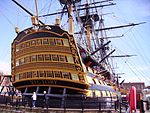Portsmouth Historic Dockyard

Portsmouth Historic Dockyard is an area of HM Naval Base Portsmouth which is open to the public; it contains several historic buildings and ships. It is managed by the National Museum of the Royal Navy as an umbrella organization representing five charities: the Portsmouth Naval Base Property Trust, the National Museum of the Royal Navy, Portsmouth, the Mary Rose Trust, the Warrior Preservation Trust Ltd and the HMS Victory Preservation Company. Portsmouth Historic Dockyard Ltd was created to promote and manage the tourism element of the Royal Navy Dockyard, with the relevant trusts maintaining and interpreting their own attractions. It also promotes other nearby navy-related tourist attractions.
Excerpt from the Wikipedia article Portsmouth Historic Dockyard (License: CC BY-SA 3.0, Authors, Images).Portsmouth Historic Dockyard
Queen Street, Portsmouth Portsea
Geographical coordinates (GPS) Address Website External links Nearby Places Show on map
Geographical coordinates (GPS)
| Latitude | Longitude |
|---|---|
| N 50.801 ° | E -1.11 ° |
Address
Portsmouth Historic Dockyard
Queen Street
PO1 3LJ Portsmouth, Portsea
England, United Kingdom
Open on Google Maps










